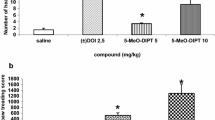Abstract
The actions of the serotonin precursor 5-hydroxytryptophan (5-HTP), the agonist 5-methoxy-N,N-dimetyltryptamine (MeODMT) and quipazine (QPZ) and the antagonists cyproheptadine, methysergide and metergoline, were studied in the rat and in the common marmoset (Callithrix jacchus). The precursor and agonists elicited head shakes, forepaw padding, splayed hindlimbs, tremor and Straub tail in the rat. However, head shakes were not observed after MeODMT and Straub tail was not observed after QPZ. Carbidopa plus 5-HTP potentiated only head shakes, while tranylcypromine (TCP) plus 5-HTP potentiated all the behaviors above. In the marmoset, the action of these drugs elicited drowsiness, teeth chattering, ataxia, vomiting and decreased motor activity, although vomiting was not elicited by MeODMT and ataxia and drowsiness by QPZ. Although TCP plus 5-HTP potentiated all these behaviors, carbidopa plus 5-HTP was not effective.
Rats treated with the antagonists (1.0, 5.0 and 10 mg/kg doses) did not show any of these behaviors, but marmosets treated with the same drugs developed “drowsiness”, vomiting, and decreased motor activity; nonetheless, cyproheptadine (5.0 and 10 mg/kg doses) did not elicit “drowsiness”, while increasing motor activity and the number of head shakes. Pretreatment of marmosets with these antagonists blocked only teeth chattering elicited by MeODMT (4.0 mg/kg) and QPZ (10 mg/kg). Pretreatment with haloperidol, p-chlorophenylalanine and α-methyl-P-tyrosine had no effect.
The data obtained show that rats and marmosets present differential behavioral responses to the 5-HT drugs used. Marmosets have a richer behavioral repertoire and show greater sensitivity to 5-HT agonists and antagonists. The data suggest that this animal might become a useful biological model for the study of central 5-HT systems.
Similar content being viewed by others
References
Bedard P, Pycock CJ (1977) Wet-dog shake behavior in the rat: a possible quantitative model of central 5-hydroxitryptamine activity. Neuropharmacology 16:663–670
Blackshear MA, Steranka LR, Sanders-Bush E (1981) Multiple serotonin receptors: regional distribution and effect of raphe lesions. Eur J Pharmacol 76:325–334
Campos F, Arruda F (1981) Pharmacologic manipulations of brain catecholamines and the behavior of Callithrix jacchus (marmoset). Psychopharmacology 73:252–256
Clineschmidt BV, Lotti VJ (1974) Indoleamine antagonists: relative potencies as inhibitors of tryptamine-and 5-hydroxytryptophan-evoked responses. Br J Pharmacol 50:311–313
Colpaert FC, Niemegeers CJE, Janssen PAJ (1982) A drug discrimination analysis of lysergic acid diethylamide (LSD): In vivo agonist and antagonist effects of purported 5-hydroxytryptamine antagonists and of piremperone, a LSD antagonist. J Pharmacol Exp Ther 221:206–214
Corne SJ, Pickering RW, Warner BT (1963) A method for assessing the effects of drugs on the central actions of 5-hydroxytryptamine. Br J Pharmacol 20:106–120
Ennis C, Cox B (1982) Pharmacological evidence for the existence of two distinct serotonin receptors in rat brain. Neuropharmacology 21:41–44
Everitt BJ (1977) Effects of clomipramine and other inhibitors of monoamine uptake on the sexual behaviour of female rats and rhesus monkeys. Postgrad Med J 53:202–210
Gillin JC, Tinklenberg J, Stoff DM, Stillman R, Shortlidge JS, Wyatt RI (1976) 5-Methoxy-N,N-dimethyl-tryptamine: Behavioral and toxicological effects in animals. Biol Psychiatry 11:355–358
Gradwell PB, Everitt BJ, Herbert J (1975) 5-Hydroxytryptamine in the central nervous system and sexual receptivity of female rhesus monkeys. Brain Res 88:281–293
Grahame-Smith DG (1971a) Studies in vivo on the relationship between brain tryptophan brain 5-HT synthesis and hyperactivity in rats treated with a monoamine oxidase inhibitor on 1-tryptophan. J Neurochem 18:1053–1066
Grahame-Smith DG (1971b) Inhibitory effect of chlorpromazine on the syndrome of hyperactivity produced by L-tryptophan or 5-methoxy-N,N-dimethyltryptamine in rats treated with a monoamine oxidase inhibitor. Br J Pharmacol 43:856–864
Jacobs BL (1976) Minireview: An animal behavior model for studing central serotoninergic synapses. Life Sci 19:777–786
Jacobs BL, Klemfuss H (1975) Brain stem and spinal cord mediation of a serotoninergic behavioral syndrome. Brain Res 100:450–457
Janssen PAJ (1983) 5-HT2 receptor blockade to study serotonin-induced pathology. Trends Pharmacol Sci 4:198–206
Leysen JE, Awouters F, Kennis L, Laduron PM, Vandenberk J, Janssen PAJ (1981) Receptor binding profile of R 41 468, a antagonists at 5-HT2 receptors. Life Sci 28:1015–1022
Macchitelli FJ, Fischetti D, Montanarelli NJ (1966) Changes in behavior and electrocortical activity in the monkey following administration of 5-hydroxytryptophan (5-HTP). Psychopharmacologia 9:447–456
Matthews WD, Smith CD (1980) Pharmacological profile of a model for central serotonin receptor activation. Life Sci 26:1397–1403
Niemegeers CJE, Colpaert FC, Leysen JE, Awouters F, Janssen PAJ (1983) Mescaline-induced head-twitches in the rat: An in vivo method to evaluate serotonin S2 antagonists. Drug Dev Res 3:123–135
Raleigh MJ, Brammer GL, Yuwiler A, Flannery JW, McGuire MT, Geller E (1980) Serotonergic influences on the social behavior of vervet monkeys (Cercopithecus aethiops sabaeus). Exp Neurol 68:322–334
Raleigh MJ, Yuwiler A, Brammer GL, McGuire MT, Geller E, Flannery JW (1981) Peripheral correlates of serotonergically-influenced behaviors in vervet monkeys (Cercopithecus aethiops sabaeus). Psychopharmacology 72:241–246
Schlemmer RF, Narasimhachari N, Thampson VD, Davis JM (1977) 5-Methoxy-N,N-dimethyltryptamine on primate social behavior. Commun Psychopharmacol 1:105–118
Scraggs PR, Ridley RM (1978) Behavioural effects of anphetamine in a small primate: Relative potencies of the d and l-isomers. Psychopharmacology 59:243–245
Scraggs PR, Baker HF, Ridley RM (1979) Interaction of apomorphine and haloperidol: Effects on locomotion and other behaviour in the marmoset. Psychopharmacology 66:41–43
Sloviter RS, Drust EG, Connor JD (1978) Specificity of a rat behavioral model for serotonin receptor activation. J Pharmacol Exp Ther 206:339–347
Trulson ME, Eubanks EE, Jacobs BL (1976) Behavioral evidence for supersensitivity following destruction of central serotonergic nerve terminals by 5,7-dihydroxytryptamine. J Pharmacol Exp Ther 198:23–32
Author information
Authors and Affiliations
Additional information
This work was partially financed by FINEP (Financiadora de Estudos e Projetos) and UFRN (Universidade Federal do Rio Grande do Norte). Portions of this work were read before 34th (1982) and 36th (1984) Annual Meeting of Brazilian Society for Advance of Science (SBPC)
Rights and permissions
About this article
Cite this article
de Campos, M.F., das Rodrigues, F.C. Rats and marmosets respond differently to serotonin agonists and antagonists. Psychopharmacology 92, 478–483 (1987). https://doi.org/10.1007/BF00176482
Received:
Revised:
Issue Date:
DOI: https://doi.org/10.1007/BF00176482




